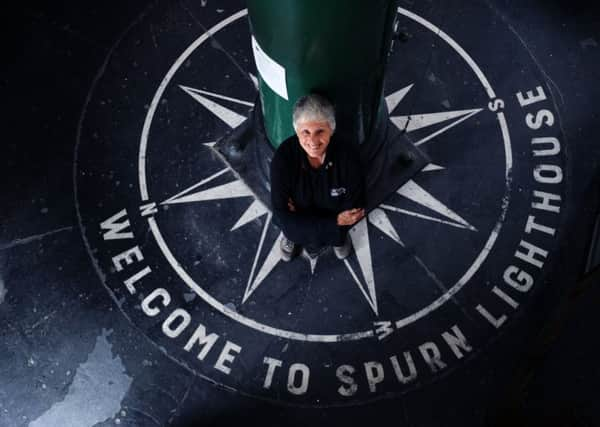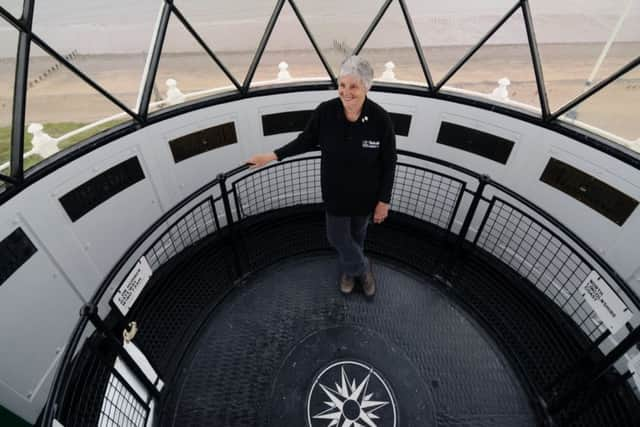Lin Sunderland: Meet Spurn Point's '˜Lighthouse Witch'


Lin Sunderland feels incredibly lucky to live at one of Yorkshire’s beautiful coastal spots for four days each month. Seals – even porpoises and whales – deer and all kinds of birds are her neighbours at Spurn Point where she’s a volunteer lighthouse keeper. Lin, 70, is one of several people happily working for nothing at the decommissioned and restored 128ft-high building. It stands on a sliver of land, just 50 metres wide at its narrowest, in a nature reserve looked after by the Yorkshire Wildlife Trust (YWT). About 30 miles from Hull, it feels like another world.
From the viewing platform in the lighthouse’s lantern room, 144 steps up, whilst soaking up the changes of mood, atmosphere and stunning views over the North Sea and Humber Estuary, it’s easy to imagine the flash of the beam warning ships miles out at sea.
Advertisement
Hide AdAdvertisement
Hide Ad“Being in a lighthouse is like going back in time,” says Lin, who calls herself the Lighthouse Witch because she has been passionate about these lifesaving structures since she was a child. “Mariners could really not have managed without them. Every lighthouse flashes differently, each one has its own character.”


Lin, originally from Liverpool, has visited more than 150 lighthouses around the world but her love affair with them began badly, at a lighthouse on the Wirral. “I was about four. My dad said men lived in it to keep the light burning so ships could find their way. But I could see those men in the tower and thought they must be at least 20 feet tall. By the time I was six I had turned them into terrifying monsters. Lighthouses were something to be afraid of.”
On a visit to a family friend who was a lighthouse keeper, Lin’s fear momentarily deepened. “My parents held my hands, I dragged my feet, not wanting to go near the monsters. But at the door of the cottage was a normal-sized man and his wife.” Inside the lighthouse she met another “normal-sized man” and they went up the stairs. When she reached the lantern room, she was immediately hooked. “I made scrapbooks and visited as many lighthouses as I could; they have been a huge part of my life. Now Spurn gives me the opportunity to say I am finally a lighthouse keeper.”
Lin’s paid jobs varied from being a cook for Australian sheep shearers and a nurse, to working in a bank and a petrol station. Her Spurn duties include sweeping the stairs (she often “runs up and down them”), being a fire warden and sharing her knowledge with visitors. She is also a member of the Association of Lighthouse Keepers (ALK), its North East regional representative and one of the trustees. She recently took 21 other members to see some Yorkshire lighthouses.
Advertisement
Hide AdAdvertisement
Hide AdLin’s love of these fantastic feats of engineering and their breathtaking locations developed further when she lived in Australia for more than 20 years and visited lighthouses there. She’s also been to the USA, France and Scotland pursuing her passion, and holidays even now regularly feature a lighthouse. Her favourite? “If pushed, Grand Island East Channel lighthouse in Michigan. And in Britain, Spurn. It has a lovely feel to it; the whole area is very special. It’s enjoyable to be part of a team helping to protect it for the future, giving something back, helping others to come and find out about this wonderful place. And you get a lot from volunteering, including new friends.”


That’s immediately clear when Lin is greeted with a hug by volunteer Larry Malkin, Spurn’s artist-in-residence. A former headteacher, one of his tasks is driving visitors along the sand for “art safaris” in the Unimog, an ex-military vehicle. He loves his Spurn life but is worried about the environment. “In these uncertain times funding to national bodies and local conservation trusts will be reduced. We can help to overcome that by encouraging more volunteers to come forward to take up some slack.” Lin echoes his concerns. “Without more volunteers to care for nature, there’ll be nothing left for future generations.”
There’s no end of disturbing facts and statistics about our wildlife. For example, it’s estimated there are less than one million hedgehogs left in Britain, the number of puffins is declining, and there are predictions there could be more plastic in the sea than fish by 2050. The YWT says 60 per cent of Yorkshire’s wildlife is threatened with extinction. But it’s not complete doom and gloom; last year’s State of Nature Report, compiled by many leading wildlife and research organisations, said it wasn’t too late to save UK nature but warned we must act now. When Sir David Attenborough visited Yorkshire last summer he said that of all the organisations he’s aware of “none is more important to the future of this country than those who are looking after our natural heritage”.
Lynn Thompson, YWT’s volunteering development manager, believes volunteers are “one of the ways we inspire other people to care about nature and to realise nature matters to us all”. People get involved for many reasons, including a love of nature, wanting to take practical action and enhancing a CV. “Whatever their motivation, they make a huge difference,” she adds.
Advertisement
Hide AdAdvertisement
Hide AdThe Lighthouse Witch is certainly motivated. Every month she travels to Spurn from her home near Richmond, 120 miles each way. She stays over in basic YWT accommodation, a cottage that is often a temporary home to other volunteers or staff too, many of them young people. The cottage isn’t far from an office where, among the furniture and paperwork, Lin sits and chats after her shift, close to a mammoth’s tusk. Found on the beach, it is likely to be displayed in Spurn’s new visitor centre, currently being built. For now, the relic is tucked away carefully under a table, a stark reminder of what extinction really means.
In the evenings, Lin can wander outside to see a starry sky before going to sleep just metres from the edge of England. Perhaps, though, the ultimate personal reward for her voluntary work is meeting the man who became her husband when they both volunteered for a heritage railway almost three decades ago.
It seems volunteering has been as much of a life- changing experience for Lin as her first time in a lighthouse, all those years ago.
HOW HELPING HANDS CAN MAKE A WORLD OF DIFFERENCE
Volunteers are crucial to the work of the Yorkshire Wildlife Trust. Volunteers enable the organisation to manage great swathes of the county’s wild places. Current opportunities include...
Advertisement
Hide AdAdvertisement
Hide AdFootpath management: In the past people have tried to fortify Spurn Point against the forces of nature, but largely these attempts have failed. The most dramatic episode occurred during the tidal surge of December 2013, which removed a section of the road, leaving Yorkshire with a newly created island at high tide. It now means access to the site is more limited than it used to be, so the trust is keen to maintain the footpaths, allowing visitors to explore the area at low tide. Spurn Point, August 2. There will also be a beach clean at the site on September 14. Contact Andrew Marsh, 07758 709257.
Balsam bashing: Himalayan balsam is an aggressive, non-native plant. Dense strands suffocate other plants, pushing out native plant communities, and when it dies back in winter it leaves bare riverbanks which are more vulnerable to erosion. Himalayan balsam also produces copious amounts of nectar which attracts pollinators away from native plants and the YWT wants to recruit volunteers to clear the worst-affected sites across Yorkshire. Kirkstall Valley, Leeds, August 8. Karen McDiarmid, 07780 666173.
Reed bed management: Reed beds have been identified as a priority for conservation. They are among the most important habitats for birds in the UK, including six nationally rare Red Data Book Birds – bittern, marsh harrier, crane, Cetti’s warbler, Savi’s warbler and the bearded tit. The management plan is designed to maintain and enhance the environment for these birds and does so by creating a mosaic of habitats appealing to the widest variety of species. Potteric Carr, September 3 and 10. Mark Roberts, 01302 365995.
Coppicing: Appleton Mill Farm in North Yorkshire is an established 230-acre beef and arable farm with 100 acres of woodland that holds many ancient flora such as bluebells, wild primrose and wood sorrel. In order for the species to thrive it uses coppicing where young tree stems are repeatedly cut down to near ground level, allowing new shoots to emerge. August 2 and 16. Peter Christopherson, 07787535812.